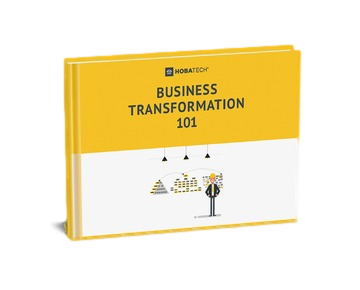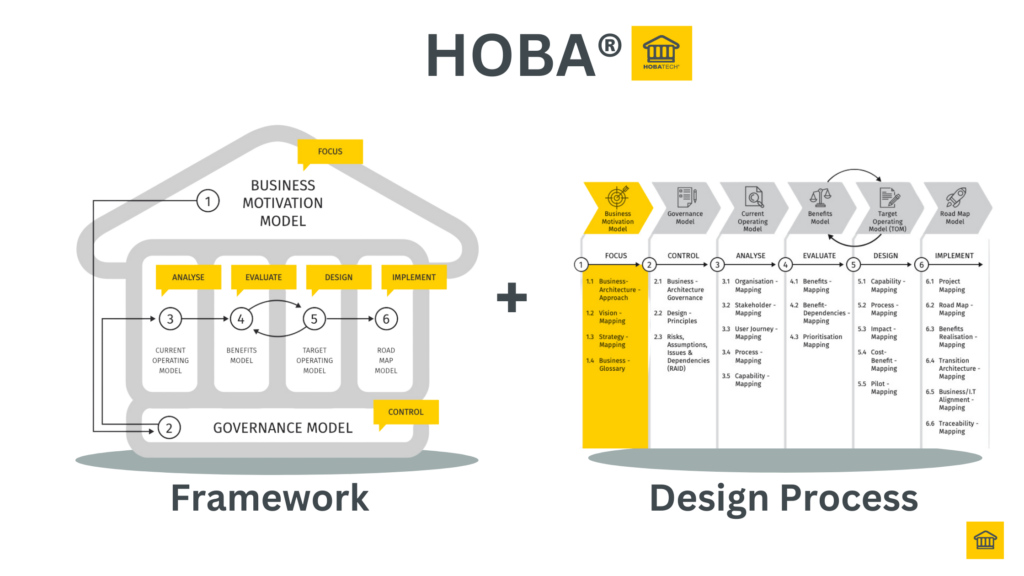In the ever-evolving landscape of enterprise architecture, organisations are constantly seeking effective frameworks to streamline their processes, enhance efficiency, and drive transformation. Two prominent methodologies in this realm are Solution Architecture and the HOBA (House of Business Architecture) framework. While both aim to address the complex challenges of modern business environments, they approach the task from different perspectives.
In this article, we’ll delve into the nuances of Solution Architecture and compare it with the HOBA Business Transformation Architect (BTA) role and the HOBA framework, highlighting why HOBA is increasingly being recognized as the preferred choice for businesses undergoing transformational journeys.
Heres what we’ll cover (click the links to skip to the section below):
NB – Click to expand images 📸
Table of Contents
Understanding Solution Architecture
Role of Solution Architect
A Solution Architect is a key player in the software development lifecycle, responsible for designing scalable, reliable, and cost-effective solutions that meet the organization’s strategic objectives. They collaborate with stakeholders to understand business requirements, translate them into technical specifications, and oversee the implementation of the solution.
Components of Solution Architecture
Solution Architecture encompasses various components, including software applications, infrastructure, data architecture, security, and integration requirements. It involves designing systems that are interoperable, flexible, and aligned with industry best practices and standards.
Benefits and Challenges
Solution Architecture offers several benefits, such as improved system performance, reduced development costs, and enhanced user experience. However, it also presents challenges, such as managing complexity, addressing evolving business needs, and ensuring alignment with organizational goals.
Introduction to HOBA Business Transformation Architect (BTA)
Overview of HOBA Framework
HOBA is a comprehensive framework that goes beyond traditional enterprise architecture approaches by integrating business strategy, processes, technology, and human capital. It provides a structured methodology for aligning business objectives with IT capabilities, driving holistic transformation across the organization.

6-Steps to Business Transformation Success
WHAT THE TOP 30% OF ORGANISATIONS KNOW THAT YOU DON’T 👉

💡 "In the battle between Solution Architecture and HOBA, it's clear: HOBA's agility and adaptability give it the edge in today's dynamic business environment." #AgilityWins 🚀 #HOBAChampion 💼🌟
Heath Gascoigne Tweet
Role of BTA in Business Transformation
The HOBA Business Transformation Architect (BTA) plays a pivotal role in orchestrating business transformation initiatives. They collaborate with business leaders to define transformation goals, identify opportunities for improvement, and develop architectural roadmaps that enable strategic growth and competitiveness.
Comparing Solution Architect and HOBA BTA
1. Scope and Focus
- Solution Architecture primarily focuses on designing technical solutions to address specific business problems.
- In contrast, the HOBA BTA takes a broader view, considering the entire business ecosystem and its interdependencies.
2. Methodology
- Solution Architecture typically follows a structured approach, emphasizing technical specifications and implementation details.
- On the other hand, the HOBA framework adopts a more iterative and adaptive methodology, allowing for greater flexibility and responsiveness to changing business needs.
3. Business Alignment:
- While Solution Architecture acknowledges the importance of aligning IT with business objectives, its primary focus remains on technical architecture.
- In contrast, HOBA places business alignment at the forefront, ensuring that architectural decisions directly contribute to strategic goals and desired business outcomes.
4. Agility and Adaptability
- Solution Architecture frameworks may struggle to keep pace with rapid technological advancements and evolving market dynamics.
- HOBA's iterative approach enables organizations to respond quickly to changes, seize opportunities, and stay ahead of the competition.
5. Collaboration and Communication
- Effective collaboration and communication are essential for successful architecture initiatives.
- HOBA fosters greater collaboration between business and IT stakeholders, breaking down silos and facilitating alignment across departments.
6. Impact on Business Transformation
- While both Solution Architecture and HOBA aim to drive business transformation,
- HOBA's holistic approach and focus on business outcomes make it better suited for addressing the complex challenges of modern organizations.
Why HOBA is Ideal for Business Transformation
1. Holistic Approach
- HOBA takes a holistic view of enterprise architecture, considering not only technology but also business processes, people, and culture. This comprehensive approach ensures that transformation initiatives are aligned with the organization's overall strategy and goals.
2. Business-centric Methodology
- HOBA places a strong emphasis on business outcomes, ensuring that every architectural decision is driven by its potential impact on key performance indicators and strategic objectives. This results in solutions that are not only technically sound but also deliver tangible business value.
3. Flexibility and Scalability
- HOBA's iterative methodology allows organizations to adapt quickly to changing market conditions, customer preferences, and technological innovations. This flexibility enables businesses to scale their operations, enter new markets, and seize growth opportunities more effectively.
4. Emphasis on Outcomes
- By prioritizing business outcomes, HOBA ensures that transformation initiatives are aligned with the organization's long-term strategic goals. This results in solutions that not only meet immediate needs but also position the organization for sustained success in the future.
Case Studies
Case Study 1: HOBA in the UK Government Sector
Government Department A: How HOBA Revolutionized their Operations in the UK Government Sector
Our Client, Government Department A, a key entity in the UK government, embraced the comprehensive HOBA business architecture to bring about a holistic transformation in their operations.
By leveraging the HOBA framework and the expertise of a HOBA business transformation architect, Government Department A successfully modernised its processes, optimised resource allocation, and improved service delivery to citizens.
This transformation allowed Our Client to adapt to the evolving needs of the UK government sector and achieve substantial improvements in its overall operations.
Case Study 2: HOBA in the Technology Industry
Company B: How HOBA Transformed Operations in the Technology Industry
Our Client, Company B, a prominent player in the technology industry, embarked on a journey with HOBA’s holistic business architecture to drive transformative changes in its operations.
With the guidance of a HOBA business transformation architect, Our Client was able to align its business strategies with the HOBA framework, resulting in improved operational efficiency, enhanced innovation, and streamlined processes.
This transformation empowered Our Client to adapt to the dynamic landscape of the technology industry and achieve significant improvements in its overall business operations.
These case studies exemplify how HOBA’s holistic framework and methodology, coupled with the expertise of a HOBA business transformation architect, have been instrumental in driving successful transformations in the UK government sector and the technology industry.
If you require further details or information about these case studies, feel free to book a call with us!

Conclusion
In conclusion, while Solution Architecture remains a valuable approach for designing technical solutions, the HOBA framework offers a more holistic and business-oriented approach to enterprise architecture. By prioritizing business alignment, agility, collaboration, and outcomes, HOBA provides a roadmap for sustainable and impactful business transformation.
🗣️ "Solution Architecture focuses on technical details, but HOBA Business Transformation Architecture takes a holistic approach, integrating business strategy and technology seamlessly." #EmbraceTransformation 💼🔧 #HOBAOverTOGAF 🚀💡
Heath Gascoigne Tweet
FAQs
A Solution Architect is responsible for designing scalable, reliable, and cost-effective (mostly, technology) solutions that meet the organisation’s strategic objectives.
HOBA takes a holistic view of enterprise architecture, considering not only technology but also business processes, people, and culture. It places a strong emphasis on business outcomes and agility, making it better suited for driving holistic business transformation.
Yes, HOBA can be implemented in organisations of all sizes and industries. Its flexibility and scalability make it suitable for adapting to the unique needs and challenges of each organization.
HOBA places business alignment at the forefront, ensuring that every architectural decision is driven by its potential impact on key performance indicators and strategic objectives. It fosters collaboration between business and IT stakeholders, ensuring that architecture
Still got questions?
Explore the Agile Transformation Accelerator training program, HOBA® for Executives, Leading HOBA 1.0, HOBA Principles, and The Agile Business Transformation Framework to deepen your understanding and drive meaningful transformation in your organisation.
Ready to take the next step? Explore our plans and pricing here and embark on a transformative journey with HOBA today.
Together, let’s unlock the potential of your business and pave the way for a future of sustainable growth and innovation.
Thank you for reading this!
Sincerely,

Heath Gascoigne
P.S. If you want to join our Business Transformator community of 2,000+ like-minded Business Transformators, join the community on the Business Transformator Facebook Group here.
P.P.S. If you want to learn more about business transformation, check out The Business Transformation Playbook here.
For more information, visit https://www.hoba.tech

















